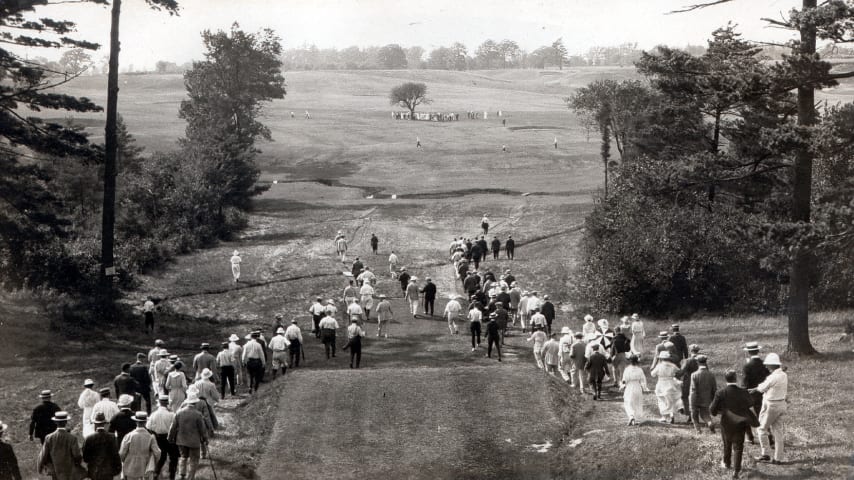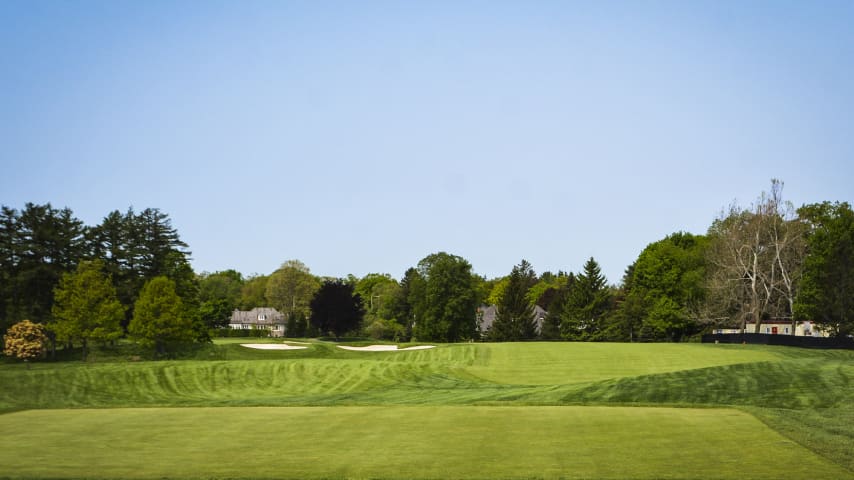Five things to know: Hamilton Golf and Country Club
6 Min Read

A view of the 18th hole at Hamilton Golf and Country Club. (Courtesy Hamilton Golf and Country Club)
Written by Adam Stanley
Hamilton Golf and Country Club, one of Canada’s top-ranked facilities, will host the RBC Canadian Open for the seventh time this week.
But the course will look very different than when the PGA TOUR was last here in 2019. Not long after Rory McIlroy’s dominant win five years ago, the club underwent a nearly $8.5-million restoration under world-renowned architect Martin Ebert.
Hamilton commissioned Ebert’s firm – which also advises on eight of the 10 venues in The Open rota, including this year’s host, Royal Troon – in 2014 to give the club a throwback look to its original Harry Colt design. Having spent time at Pine Valley in 1913, Colt came to Hamilton a year later. The official club opening was in 1916.

A view of the 11th hole during 1919 at Hamilton Golf and Country Club. (Courtesy Hamilton Golf and Country Club)
Ebert and design partner Tom Mackenzie had never done a restoration effort like the one at Hamilton. Most of the work was overseen from afar due to the COVID-19 pandemic and the travel restrictions, but it worked.
Golf Digest named Ebert’s work on Hamilton the "Best Renovation" of the year in January 2023.
“Harry Colt is one of the world’s greatest – if not the greatest – architects so having one of his rare North American golf courses is a keystone element of what makes Hamilton special,” said Andrew Harvie, an authority in Canadian golf architecture and founder of Beyond the Contour. “In technical terms, the routing is brilliant, with the layout largely routed in triangles around the hilly property with the Ancaster Creek on the bottom.
“How the layout handles the severity of the property while giving players fresh looks and strategies on every tee is a clinic in routing.”
With the RBC Canadian Open returning to Hamilton – before heading to TPC Toronto at Osprey Valley in 2025, a debut venue – here’s everything else you need to know about the iconic Canadian club.
It's the same but different
Hamilton’s membership voted in favor to proceed with a Golf Course Improvement Plan Project about a month before McIlroy’s seven-shot triumph at the RBC Canadian Open in 2019. The plan included reconstructing tees, bunkers and greens on all 27 holes (the West/South PGA TOUR layout along with the East). There would also be a new irrigation system, practice putting green and new practice area.
“The players want to enjoy the experience of playing the golf course so that’s a big component of (an event’s success) and the amazing thing is that it was really well received, and it was fantastic before,” tournament director Bryan Crawford said. “The fact that it’s gotten even better – it’s almost unthinkable that it could have gotten better than it already was.”
Ebert said Hamilton’s topography was always its distinguishing factor.

A view of the first hole at Hamilton Golf and Country Club. (Courtesy Hamilton Golf and Country Club)
“The impressive nature of the terrain, that was the key thing,” he said. “Whether it’s a new piece of land or an existing course, how many times do you stand on a tee and have your breath taken away? That’s pretty regular at Hamilton. That was one of the first takeaways.”
A legend still called the shots
Although Colt only came to Hamilton once, Ebert said he and his team wanted to “pay as much respect” to Colt as possible. The club had all the old plans, with descriptions of the bunkers, which Ebert called “so important” to the appearance of courses and specific holes.
“I was really pleased how they worked out,” Ebert said, “especially given our restrictions on travelling and not being able to get there during any of the construction. That was a real positive for me.”
The club’s original set of 1914 drawings from Colt included ragged edges, additional depth and “fescue eyebrows” near the bunkers, which players will see once again. SCOREGolf.com reported in 2021 – when the course first re-opened – that Ebert compared Hamilton’s bunker renovation to the recent work he did at Royal Portrush.
Tech provided COVID-19 workaround
Ebert was expected to make about 12 visits to Hamilton for the project but those were all cancelled due to the pandemic. Drone technology, 3D video and even virtual reality allowed him and his team to review the progress, finalize approvals and make changes remotely.
He finally saw the course in person in September 2021.
“It would have been far better to review our design and the contractor work on the ground, there’s no doubt about that,” Ebert said. “But we couldn’t. As a result of the techniques we developed during COVID, and since our detailed plans give so much information to the contractor, we had the confidence we could still pull it off to an extremely high standard.”
He admits it took one hole (the fourth) to really settle in on a process for the contractor and Ebert, but they got rolling quickly after the virtual back-and-forth style was agreed upon.
“It was a challenge, but we weren’t petrified because we do really concise levels (of planning),” Ebert said. “Having the VR headset and 3D camera was so instrumental with the bunker shape, bunker depth and green surrounds. It was exciting to develop those innovative techniques and we’ve used them in other projects like doing bunkers in Chile.
“Doing Hamilton with those techniques taught us a lot.”
Even the toughest holes got longer
The golf course will play 112 yards longer than it did in 2019. The par-3 sixth, the second-most difficult hole at the 2019 RBC Canadian Open, will play 25 yards longer. The par-4 seventh (new back tee) will play 35 yards longer.

A view of the sixth hole at Hamilton Golf and Country Club. (Courtesy Hamilton Golf and Country Club)
The par-4 11th hole (21 additional yards) and par-4 14th (24) will require additional pop, as will the par-5 17th, which now measures 580 yards (30 yards longer with an entirely new green site that has been pushed back and to the left), and the par-4 18th (the hardest hole during the 2019 Canadian Open got an additional 11 yards).
Ebert said he’s hopeful the course will demand more precise ball-striking. The new greens will have more areas for pin positions and the bunkering will force players to think their way around the course.
The objective of the renovation, according to Harvie, was to create a cohesive version of the course, which had received numerous tweaks by numerous architects over the generations.
“In the renovation, they addressed all these,” he said. “Trees are out to allow some rediscovered views across the tumbling property, while mow lines are back expanded out, and greens and bunkers are uniform and consistent across the entire property.”
'The Rink' returns
A smiling Ebert said he never could have imagined that one of the holes on a course he’s worked on would be wrapped in hockey boards. But "The Rink" (in its sixth year) will make another appearance at Hamilton.
The par-3 14th hole will have the hockey-inspired atmosphere, complete with an organist, which is new this year. Ebert, who was in Hamilton for the 2019 Canadian Open, called it a “brilliant atmosphere” at The Rink.

A view of the 14th hole at Hamilton Golf and Country Club. (Courtesy Hamilton Golf and Country Club)
“When players were coming on to the tee – that was fantastic,” he said. “I really, really did enjoy that. I’m not sure it’ll happen at The Open. But even there, they want a good par 3 to excite the crowds. But nothing quite as intense as a cauldron of atmosphere like we’ll have with the hockey hole.”
“It's a marquee hole for us,” added Crawford. “It allows for us to bring it tournament to tournament when we go to different venues. I don’t think anybody could have dreamed when that idea was brought forward that it would have grown to what it is today.”




